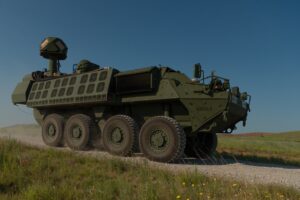The House Armed Services Committee is seeking information from the Army on the acquisition strategy for its Stryker-mounted 50-kilowatt laser effort, citing the program’s recent successes during prototype testing.
The committee adopted an amendment from Rep. Pat Fallon (R-Texas) during the markup of its fiscal year 2023 National Defense Authorization Act on Wednesday signaling support for the Directed Energy Maneuver-Short Range Air Defense (DE M-SHORAD) capability while calling for insight into the Army’s plans for transitioning the system into a program of record.

“The committee is aware of the recent testing with the Directed Energy Maneuverable Short-Range Air Defense prototype, including the successful defeat of threat UAS and mortar rounds,” Fallon writes in his amendment. “The committee urges the Army to continue its testing and delivery of system prototypes in order to provide an effective and cost-efficient counter-UAS and counter-[rockets, artillery and mortar] (RAM) capability.”
DE M-SHORAD is an Army Rapid Capabilities and Critical Technologies Office (RCCTO) program to deliver an on-the-move laser system capable of taking down unmanned aerial systems, rotary-wing aircraft and rockets, artillery and mortars, with the first set of prototypes set to be delivered to a unit at Fort Sill in Oklahoma by the end of September (Defense Daily, Jan. 13)
The Army’s current DE M-SHORAD prototyping effort involves Raytheon Intelligence and Space [RTX] as the lead laser module integrator, with Kord Technologies providing the 50-kilowatt laser system.
Last November, the Army announced plans to award Kord Technologies another prototype deal to deliver eight additional DE M-SHORAD prototypes, with four to be delivered in fiscal year 2023 and four more in FY ‘24 (Defense Daily, Nov. 19).
The recent testing with the DE M-SHORAD prototype at White Sands Missile Range in New Mexico included using the Stryker-mounted laser to successfully defeat 60mm mortar rounds and several small, medium and large drones (Defense Daily, May 16).
While the DE M-SHORAD program is set to eventually transfer from RCCTO over to the Army’s Program Executive Office Missiles and Space, a final path has not been detailed yet on plans for a full and open competition to award the eventual production contract.
Fallon’s amendment directs the Army’s top acquisition official to brief HASC by next February on the DE M-SHORAD acquisition strategy, to include information of the program’s development, testing, production schedule and funding profile, and plans for transitioning into a program of record.
The briefing would also cover plans for integrating systems such as DE M-SHORAD into the Army’s new Integrated Air and Missile Defense Battle Command System and any interest from other entities across the department in acquiring defense directed energy counter-drone and RAM capabilities.
Lockheed Martin [LMT] said last October it is developing the Directed Energy Interceptor for Maneuver Short-Range Air Defense System, or DEIMOS, in pursuit of the expected DE M-SHORAD production competition in FY ‘23, with plans to demonstrate the capability in late 2022 (Defense Daily, Oct. 11).